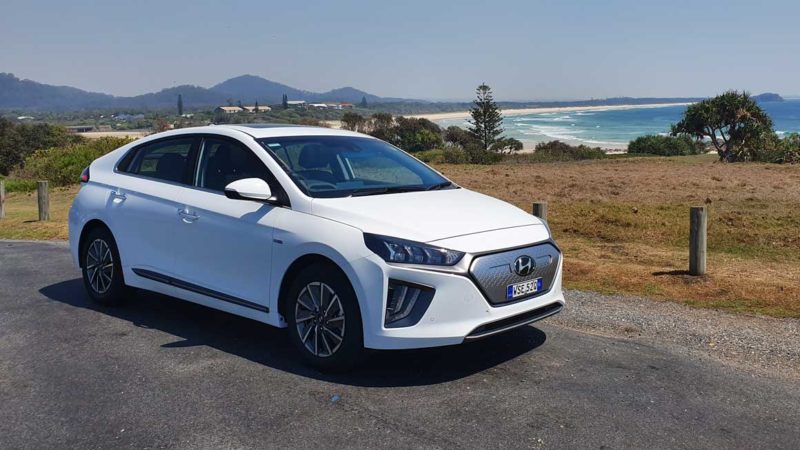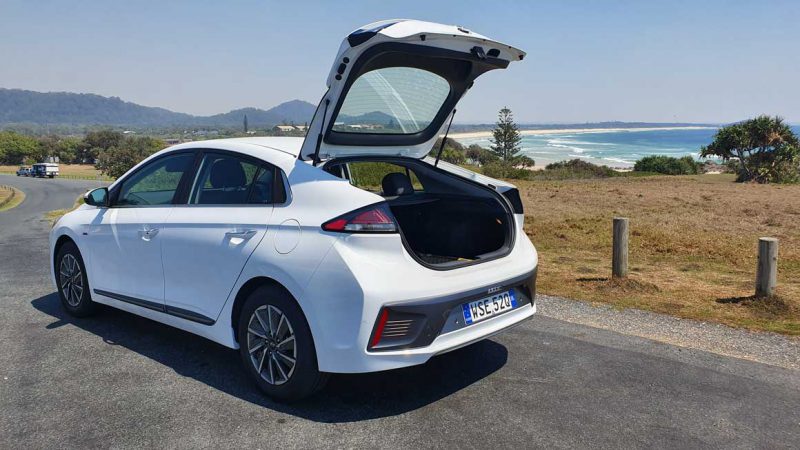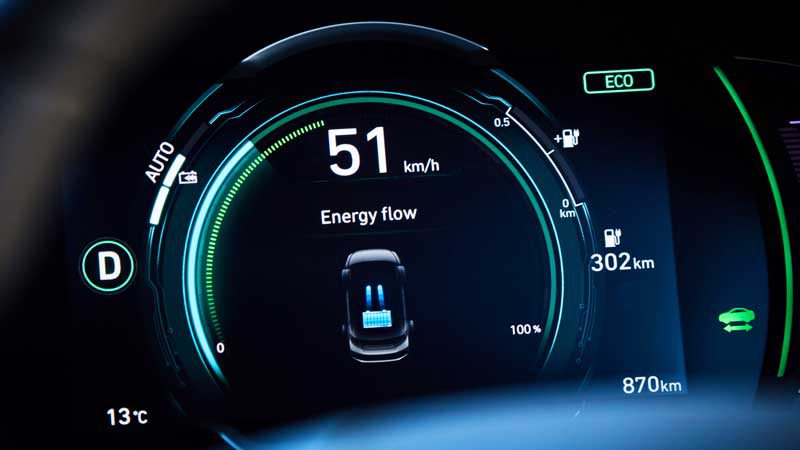Hyundai’s 2020 Ioniq Electric review: Good range, good price, and great fun

Compared to its stablemates, the plug-in hybrid (PHEV) and hybrid Ioniqs, the new 2020 electric Hyundai Ioniq, with 311km range and a 38.3kWh battery, sits at the top of the price range from $48,490 for the Elite Trim and $52,490 for the Premium trim, both before on road costs.
This fully electric Ioniq is really fun to drive, a zippy fastback that delivers the manoeuvrability of a small car and a generous hatch for luggage and shopping.

Unlike the plug-in hybrid version, which we reviewed earlier, the Ioniq electric car performs well in conditions requiring extra power like hills and highways, and that is thanks to the instant power afforded by its pure electric drive train.
The 2020 Ioniq electric car replaces its 2019 predeccessor, with 30% extra range from the larger battery, at a cost of an additional $4,000 – and it is worth the extra dosh.
It really does make the Ioniq electric a viable option for those wanting to make the switch to zero emissions transport but not wanting to make the stretch to higher specc’d and more expensive models.
The 300 kilometres plus driving range is of course indicative, and how much you get out of the Ioniq will depend on factors including driving style, topography and road type (local vs highway).
Power, range and consumption
On the highway, the 100kW motor (which replaces the 2019 model’s 88kW) delivering 295Nm torque has plenty of zip to navigate lane changes and overtake trucks. My only criticism is that there is a fair amount of road noise, so although you are spared the noise of an internal combustion engine, riding in the car at high speed is not exactly silent.Driving at 110km/hr, I used around 16kWh/100km of energy, and driving on a combination of roads – including 60 and 80km/hr local roads, and highways – I used 12.9kWh/100km.
Driving modes
The Hyundai Ioniq has 3 driving modes- Eco, Normal and Sport which can be toggled using a button on the centre console. The default level of regenerative braking (otherwise known as recuperation) level is set in the driving mode and can be altered in Setup, along with settings for climate-control and in the case of the Eco mode, a maximum speed limit.Eco mode offers a bit more resistance to acceleration, steering and of course recuperation (depending on your settings above).
Which driving mode you choose has a small effect on the driving range shown on the dash interface, and obviously this will differ more, depending on how you drive. So if you’re really pushing distances it is best to stick to mild acceleration and even speeds wherever possible.
Which mode you are in will give you a different display behind the steering wheel, with colour-coding to match – Green/blue for Eco, blue for normal and red for sport.
In Eco mode, a green bar on the speedometer encourages you to drive economically and avoid high power usage.

Regeneration
As mentioned above, you can change the default setting for the regenerative braking. There are 4 levels including “Level 0″ which still recuperates energy according to the energy flow display (you can view this in either the 10.25” touch screen or in the display in front of the steering wheel).In Normal and Sport modes however, Level 0 feels more like coasting although the energy flow display still shows energy flowing back to the battery.
While driving you can change the regenerative braking level by using the paddles behind in the steering wheel and in front of the indocators sticks. The left hand increases the braking level ie, (increases resistance), while the right hand reduces it.
Handling
The low profile and centre of gravity thanks to the low set battery pack and fastback style body give you all the grip you need to take corners with confidence and without too much braking.Combined with speedy acceleration for lane changes and overtaking, and a small turning circle to navigate tight spots, I found the 2020 Ioniq was fun to drive and would consider it as a purchase myself.
Interior
The 2020 Ioniq electric has had a design refresh that includes a new dash and cool blue mood lighting in all Premium and electric variants – it’s a nice touch which enhances the improved feel of the vehicle.In the centre console controls you can activate front seat heating and cooling options, drive mode options, and the option to see behind the car while you’re driving.
Technology, EV settings and connectivity
I love the fact that you can drop your phone in the wireless charging slot but can’t for the life of me understand why it faces the screen towards the front of the car which means that on a sunny day the phone could be left heating up which is as we know not ideal for the battery.The navigation system, whether or not you have a destination plugged in, will let you know about upcoming changes in speed limit and other road features such as zebra crossings, rail crossings and more (these can be selected or deselected in the settings interface).
The digital touchscreen interface are is very customizable as noted in the PHEV review, with immediate access to map, radio, media and a customizable star icon next to the climate controls, as well as an EV icon.
This will show you EV specific information such as the closest DC fast charger, battery charge status, and AC and DC charge limits.
You can search for a list of the nearest alternative nearest stations although check if Hyundai has updated this if purchasing, as the one I drove had only loaded Queensland stations (at the very least it wasn’t showing the new NRMA charger at Byron Bay’s The Farm).
You can also set default charging times, so if for example you have a regular routine such as going to work and you want to take advantage of discount overnight charging tariffs at home, you can set times and location to charge.
Overall, the 2020 Ioniq electric is great value for money. For the mid-$50,000 mark you get enough range to get about without worrying about running out of power (and even when having to backtrack a lot you can still recover enough range in 45 minutes to keep you going, as long as you have access to a DC fast charger).
But it’s not just value for money – while its 300km+ range gives peace of mind at the right price, it is also just plain fun to drive.

Bridie Schmidt is lead reporter for The Driven, sister site of Renew Economy.
She specialises in writing about new technology, and has a keen
interest in the role that zero emissions transport has to play in
sustainability.
Check out our Models pages for news and analysis, reviews and road trips on this and all EV models currently or soon to be available in Australia.
No comments:
Post a Comment